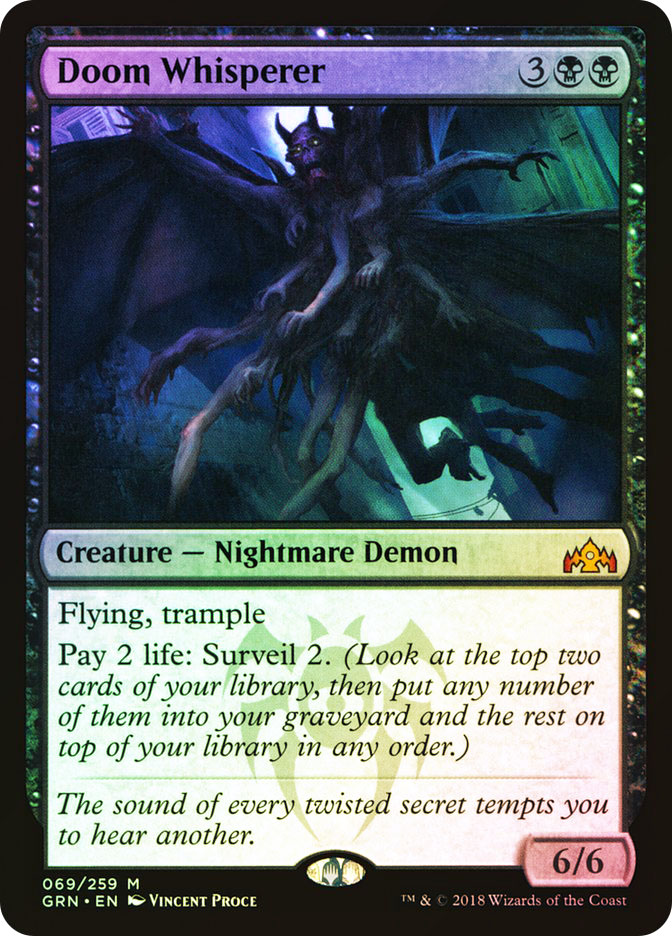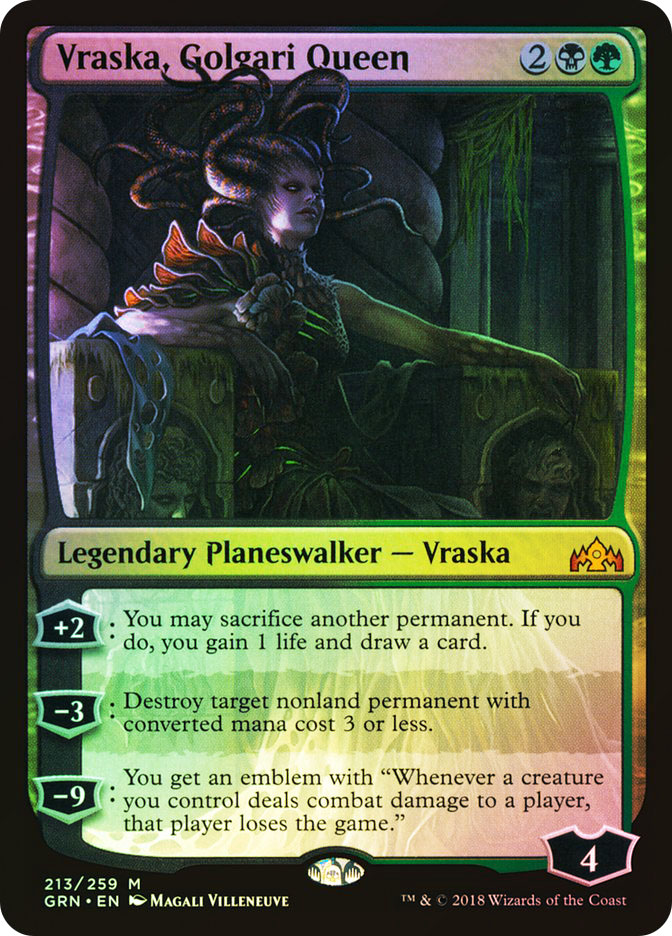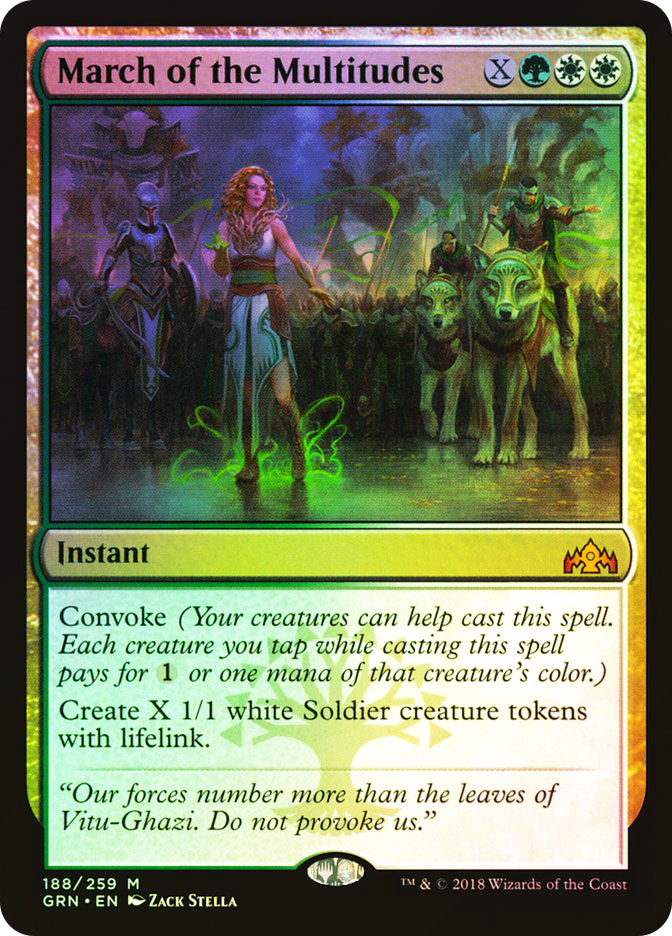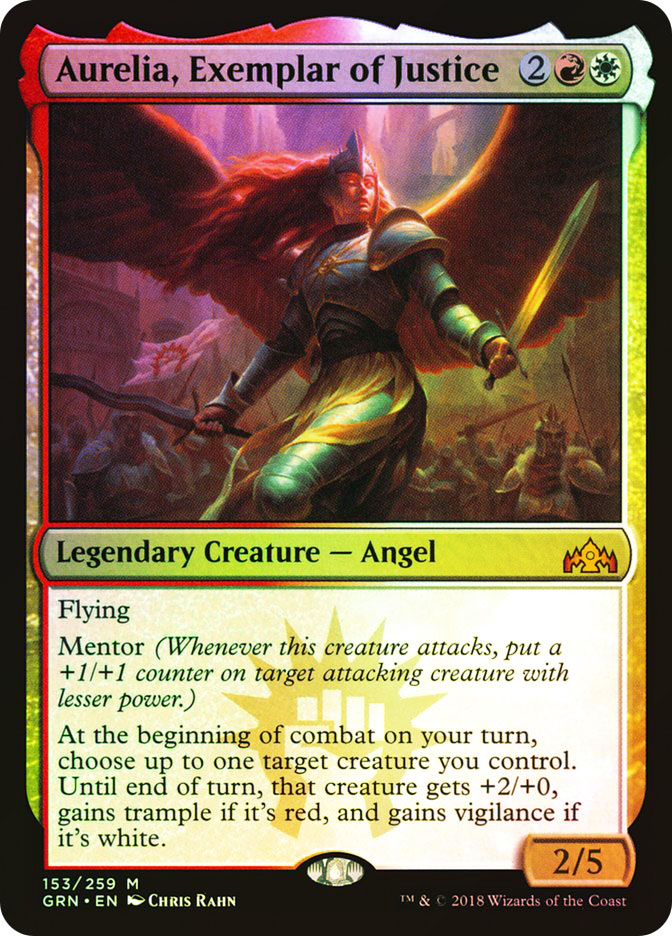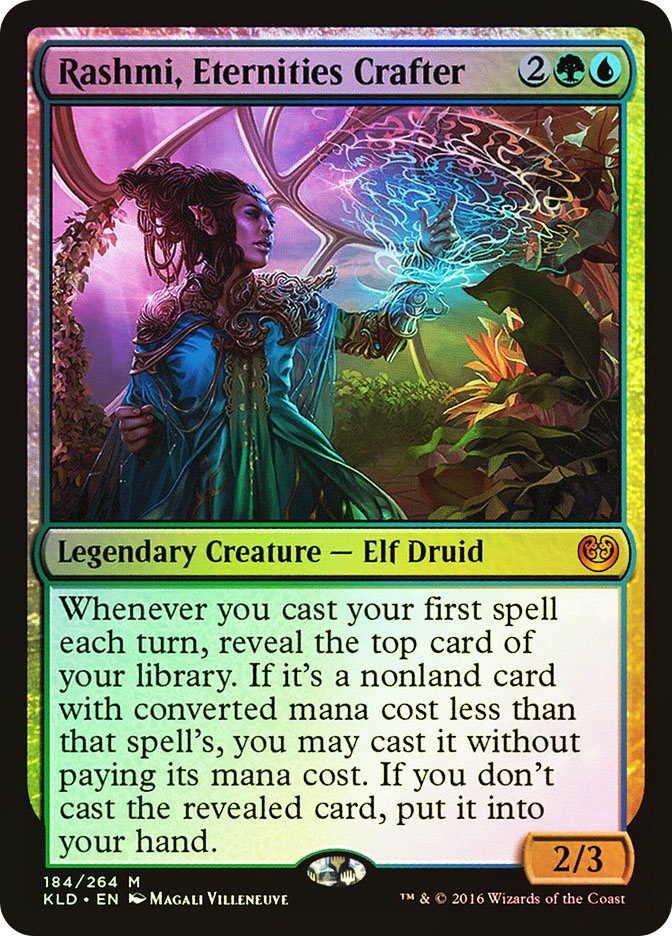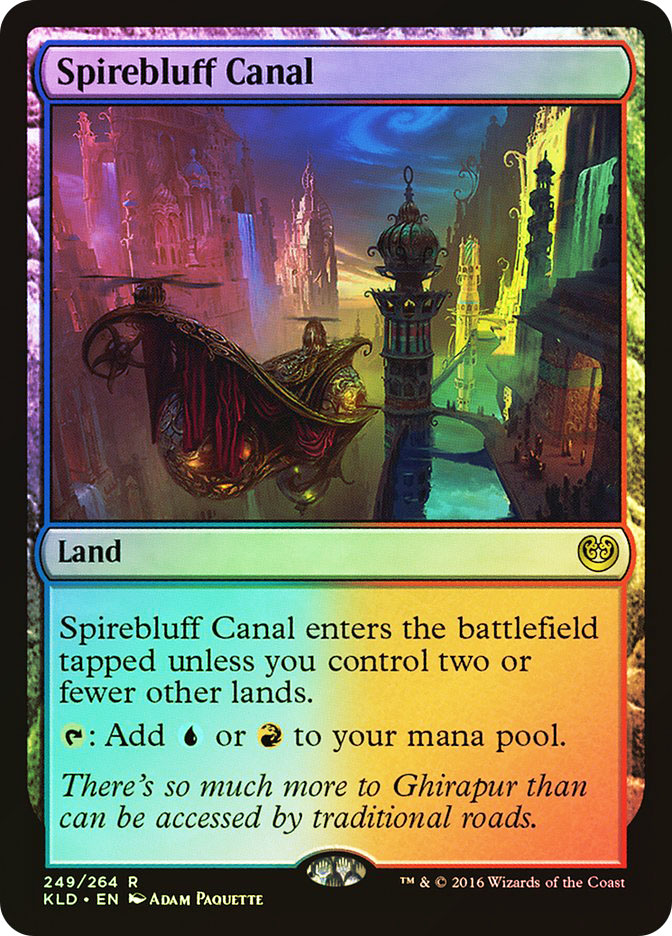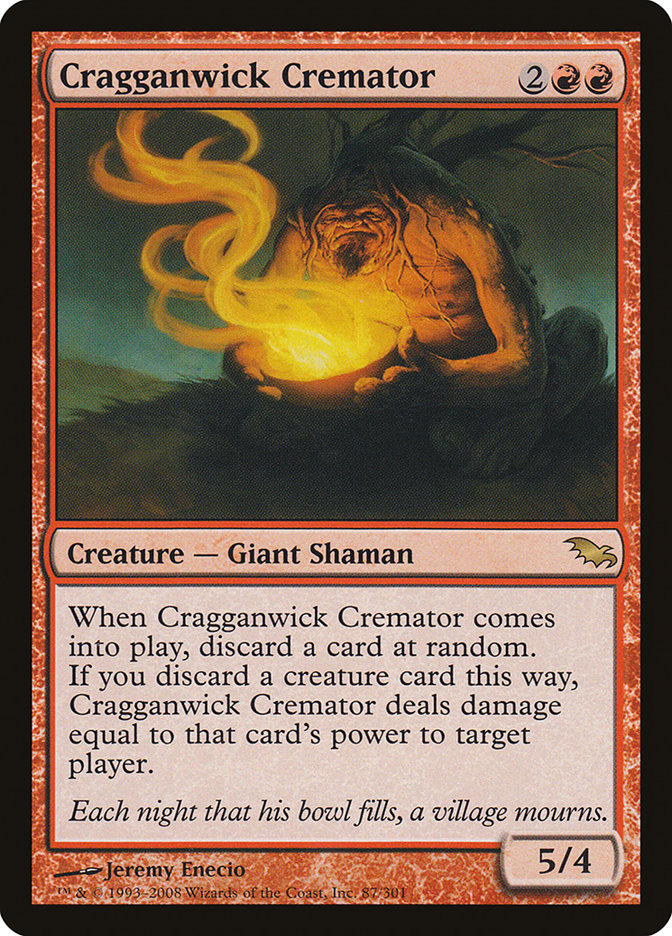We don’t spend nearly enough time talking about foils. Especially Standard
foils.
If you manage to open a Doom Whisperer in your next Guilds of Ravnica draft, you probably already know what you’re
going to do with it. Either you’re in the market for one, you know someone
who is, you’ll throw it in your trade binder, or it’ll end up in your next
buylist order. Regardless, the decision will be relatively straightforward.
But what if you open a foil Doom Whisperer? That card currently has a book
value of $39.99, which makes it the most expensive foil mythic in Guilds of Ravnica. That seems impressive until you realize that
non-foil Doom Whisperers sell for $29.99. Wait, what? A foil Doom Whisperer
is only worth $10 more than a non-foil Doom Whisperer? That can’t be right.
Foils are supposed to be worth about two times as much as non-foils, so
what the heck is up with Doom Whisperer? Is the foil underpriced? Is the
non-foil overpriced? Should you be grateful to get $40 in trade value for
your foil, or should you stick it in the back of your binder until you get
an offer you can’t refuse?
Or what about a card like Chance for Glory, where the foil is worth four
times as much as the non-foil despite not being played in anything? This
doesn’t make sense either. Clearly, some our heuristics for evaluating
Standard foils are either outdated or flat-out wrong.
That’s why today’s article is so important. Instead of simply relying on
conventional wisdom to evaluate foil prices, we’re going to dig deep into
the numbers and see what the math has to say. Is everything we know about
Standard foils wrong? Let’s find out.
What We Think We Know
When it comes to foils, especially Standard foils, conventional wisdom
hasn’t changed much over the past decade. Here are the three things that
everybody knows about foils:
-
Most foils are worth roughly twice as much as their non-foil
counterparts. When in doubt, you should probably default back to
this 2x multiplier. -
Foils that are good in Modern are worth more than two times as much
as non-foils. People usually assign a 3x or 4x multiplier to these
cards, but it can be more for exceptional cards like when Deathrite
Shaman was still legal in Standard, Modern, and Legacy. -
Foils that are good in Commander are also worth 3-4 times as much
as their non-foil counterparts. This is far more nebulous rule,
though, and it will vary a lot depending on who you’re dealing
with. Usually, these larger casual multipliers only apply to flashy
legendary creatures, planeswalkers, and Chromatic Lantern-level
Commander staples and not, like, random bulk rares.
And that’s about it. Obviously, about 98% of trades that happen these days
are made with both players looking up the value of their respective cards
beforehand, but you’d be surprised at how often people’s preconceived
notions about the price of a card end up playing a factor in terms of
closing the deal. If someone expects to get 3-4 times the non-foil value
for their foil, they’re probably not going to trade it to you for a 2x
multiplier even if that’s what StarCityGames shows them. Conversely, it’s
easier to get cards with a 5-6x multiplier at a trade discount if your
trade partner doesn’t realize that they’ve got a really hot foil until
after they’ve looked it up. Not only is analyzing conventional wisdom
important in determining which foils to buy and which to sell, but it’s a
crucial part of building a successful trade.
Now that we know what we think we know, let’s take a look
at some real-world numbers.
The Guilds of Ravnica Mythic Rares
Here are all fifteen mythic rares from Guilds of Ravnica, sorted
by their current foil multipliers. If a card’s multiplier is two, that
means that the foil is currently selling for two times as much as the
non-foil. If a card’s multiplier is six, that means that the foil is
selling for six times as much.
Note that I’ve included the non-foil price, followed by the foil multiplier
(rounded to the nearest 0.5), in descending order:
- Mnemonic Betrayal – $2 (6x)
- Chance for Glory – $1.50 (4x)
- Thousand-Year Storm – $3.50 (3.5x)
- Lazav, the Multifarious – $5 (3x)
- Ral, Izzet Viceroy – $10 (2.5x)
- Underrealm Lich – $5 (2.5x)
- Trostani Discordant – $4 (2x)
- Divine Visitation – $6 (2x)
- Nullhide Ferox – $7 (2x)
- Vraska, Golgari Queen – $15 (2x)
- Arclight Phoenix – $17 (2x)
- March of the Multitudes – $15 (1.5x)
- Dream Eater – $8 (1.5x)
- Aurelia, Exemplar of Justice – $16 (1.5x)
- Doom Whisperer – $30 (1.5x)
Fascinating, right? Based on this list, it’s clear that most foils are
worth roughly two times as much as their non-foil counterparts, but the
distribution is far wider than I’d expected it to be.
First off, the three cards with the largest multipliers-Mnemonic Betrayal,
Chance for Glory, and Thousand-Year Storm-are the three cheapest mythics in
the set. On the flip side, the card the with lowest foil multiplier-Doom
Whisperer-is the most expensive mythic in the set.
After seeing these numbers, my first thought was that this might just be
some quirk of the StarCityGames pricing model. Maybe we just haven’t
adjusted the foil price down correctly on the cheaper, more disappointing
cards yet because Guilds of Ravnica is still sort of new? Nope. I
checked a few other sites, and these foil multipliers are roughly the same
no matter where you look.
So what’s actually going on here? Well, it’s worth reminding ourselves that
foil cards are actually a lot more scarce than their price tags would
indicate. Mythic rares show up at a rate of once every eight packs, so a
specific mythic rare will pop up once every 3.33 boxes or so. Foil mythics
only show up once every 216 packs, though, so a specific foil mythic rare
is only going to appear once every 90 boxes. While I’ve seen some
conflicting numbers on foil odds that would put it closer to one in every
60 boxes or so, it’s pretty clear that foil mythics are at least fifteen or
twenty times rarer than non-foil mythics.
So why are foils only worth about twice as much as non-foils instead of
twenty times as much? It’s because demand is lower. A lot of people need
Vraska, Golgari Queen for their Golgari Midrange decks, but only a few
people want to pay up for a foil copy of Vraska-either because they want to
foil out their Standard deck, or for their cube, or their Commander deck,
or even just because they collect foil Planeswalkers.
And because the supply of foils is so small and the audience skews so
casual, the demand curve for these cards tends to be a lot narrower than it
is for non-foils. In the world of non-foils, there isn’t much demand for
Mnemonic Betrayal because it doesn’t see play in any competitive decks and
there are more than enough copies out there to satisfy the relatively
meager demand that exists for the card. But since foil mythics are twenty
times more scarce, there aren’t enough foil copies of Mnemonic Betrayal out
there yet to justify a bulk mythic price tag.
On the other side, non-foil copies of Doom Whisperer are $30 because
competitive Standard players need them to build decks. But most casual
players don’t care about that, and since it sure looks like Doom Whisperer
isn’t going to be a major player in Modern at any point, it has the look of
a card that’ll tank pretty hard after rotation. Thus, it’s having a very
difficult time maintaining more than the absolute bare minimum of a foil
multiplier.
So. On average, a cheap foil mythic from a Standard-legal set is likely to
have a multiplier over two while an expensive foil mythic from a
Standard-legal set probably has a multiplier under two. But what else can
we glean from these facts and figures?
Well, it’s clear that the more a card derives its value from Standard
playability, the lower its foil modifier. March of the Multitudes, Aurelia,
Doom Whisperer, and Dream Eater have the lowest foil modifiers, and they’re
all cards that are expensive either because they’re all either good in
Standard or they’re supposed to be good in Standard.
On the other hand, cheaper Commander cards seem to have the highest
modifiers-at least so far. Lazav, the Multifarious and Underrealm Lich have
been competitive disappointments, but casual players have been putting them
to great use. This jibes with existing common knowledge, so I don’t feel a
need to delve any deeper into this assertion.
Lastly, we can’t really make too many assertions about Modern playability
from what we see here. Arclight Phoenix is the only real “Modern Staple” on
this list, and I’m putting that in quotes because it’s probably too early
to call it that for sure. Foil copies of Arclight Phoenix are also sold out
right now, and I suspect they’ll be restocked at a slightly higher price.
But enough about the mythics. What about Guilds of Ravnica‘s
rares? Let’s take a look.
The Guilds of Ravnica Rares
- ALL BULK RARES – $0.50 (4x)
- Izoni, Thousand-Eyed – $1 (4x)
- Beast Whisperer – $1.50 (4x)
- Unmoored Ego – $1.50 (4x)
- Tajic, Legion’s Edge – $1.50 (4x)
- Mausoleum Secrets – $1.25 (4x)
- Etrata, the Silencer – $0.75 (4x)
- Niv-Mizzet, Parun – $3 (3.5x)
- Blood Operative – $0.75 (3.5x)
- Mission Briefing – $4 (3x)
- Dawn of Hope – $1 (3x)
- Swiftblade Vindicator – $1 (3x)
- Experimental Frenzy – $6 (2.5x)
- Thief of Sanity – $3 (2x)
- Chromatic Lantern – $4 (2x)
- Venerated Loxodon – $2 (2x)
- Knight of Autumn – $7 (2x)
- Assassin’s Trophy – $25 (2x)
- ALL SHOCKLANDS – Various (2x)
- Pelt Collector – $5 (2x)
- Emmara, Soul of the Accord – $1.25 (2x)
- Find – $3 (1.5x)
- Legion Warboss – $6 (1.5x)
- Expansion – $5 (1.5x)
- Deafening Clarion – $4 (1.5x)
- Ionize – $7 (1.5x)
- Risk Factor – $12 (1.5x)
- Ritual of Soot – $3 (1.5x)
- Runaway Steam-Kin – $8 (1.5x)
Interesting. So just like with the mythics, the cheapest rares in Guilds of Ravnica also have the highest foil modifiers. Of course,
we’re taking about a lot of cards that are $0.50 in non-foil and $1.99 in
foil, so that 4x modifier doesn’t really mean much. Most of these bulk rare
foils are easy enough to find in the $1 range at big events, too, so it’s
not like you can make a ton of money by exploiting this small difference in
public perception.
As with the mythics, we can see that most of the priciest Standard-only
cards have the lowest foil modifiers. Cards like Deafening Clarion, Ionize,
and Ritual of Soot aren’t great in either Modern or Commander, so you’re
simply not going to get much of a premium for your pretty, shiny Standard
staples.
Yet again, we can see that the best legendary creatures are operating with
a 3-4x Commander multiplier. Cards like Izoni, Thousand-Eyed, Niv-Mizzet,
Parun, and Tajic, Legion’s Edge are up at the top of that list due to
casual demand, and I don’t expect that to change.
Interestingly enough, the best Eternal cards on this list don’t seem to be
commanding much of a premium yet. Knight of Autumn, Assassin’s Trophy, Pelt
Collector, and the shocklands have all seen various play in Modern, and
they’re rocking just a 2x multiplier still. Risk Factor and Runaway
Steam-Kin look like they’re on the road to Modern respectability as well,
and they’ve got multipliers of just 1.5!
Coming into this article, I would have expected those multipliers to be
larger, but the truth is that Modern playability isn’t much of a concern
yet for cards that are still so expensive due to their role in Standard. I
like Risk Factor in Modern, but if the non-foil is worth $12 mostly because
of Standard play, is it really worth dropping an extra $6-$8 on a foil for
my Modern deck, or should I just wait for rotation and get the foil at a
discount? After all, I’d rather spend $10 on a foil in two years than $20
on that foil now, regardless of how high the modifier is.
And this is where we need to start looking into the past for answers about
the future. Now that we know what foil multipliers look like for a set
that’s about a month and a half old, I think it’s time for us to see how
those figures change over time. For example, what do foil prices look like
for a set that has just rotated out of Standard?
Kaladesh
Mythic Rares
- Rashmi, Eternities Crafter – $1.50 (5x)
- Saheeli Rai – $5 (5x)
- Verdurous Gearhulk – $1.50 (4x)
- Chandra, Torch of Defiance – $13 (3.5x)
- Angel of Invention – $2 (3x)
- Noxious Gearhulk – $2.50 (3x)
- Combustible Gearhulk – $2 (2.5x)
- Torrential Gearhulk – $3.50 (2.5x)
- Metallurgic Summonings – $1.75 (2.5x)
- Aetherworks Marvel – $1.50 (2x)
- Cataclysmic Gearhulk – $1.50 (2x)
- Demon of Dark Schemes – $1.50 (2x)
- Dovin Baan – $2.50 (2x)
- Nissa, Vital Force -$5 (2x)
- Skysovereign, Consul Flagship – $1.50 (2x)
Welcome back to Kaladesh! Sorry to revisit these cards so soon. At
least it’s under different circumstances this time.
Straight off the bat, we can see that all of the sub-2 foil multipliers are
gone. This has less to do with the foils having gone up in price (they have
not) and more to do with the non-foil prices dropping like a rock. If
Skysovereign, Consul Flagship is going to be easily available for just
$1.50, there’s no way its foil is going to be less than $3.
More interestingly, we no longer see massive multipliers for mythics that
were formerly among the least popular cards in the set. Metallurgic
Summonings and Demon of Dark Schemes were arguably the Mnemonic Betrayal
and Chance for Glory of Kaladesh, and the foil copies of each are
now worth…well, they’re not pure bulk, but it’s clear that enough boxes of
the set have been opened to satisfy demand, even for the foil copies of
these cards. This tells me that if you’ve opened some sweet low-end foil
mythics with high multipliers early in the life of a set, you’re probably
going to want to sell, trade, or buylist them ASAP.
But some of Kaladesh‘s foils are still doing well. Yet again, the
highest multipliers in the set belong to Commander cards. Rashmi,
Eternities Crafter is the only legendary creature here, so it’s
unsurprising that she has the biggest modifier. The set’s two good
planeswalkers are looking good as well.
This is a fairly uninspired list overall, though, and most of these cards
simply aren’t in very much demand right now, foil or not. Par for the
course with rotating sets, I suppose.
Kaladesh
Rares
- Animation Module – $0.50 (16x)
- Kambal, Consul of Allocation – $1 (8x)
- Gonti, Lord of Luxury – $0.59 (7x)
- Bomat Courier – $1 (6x)
- Paradoxical Outcome – $1.25 (5x)
- ALL BULK RARES – $0.50 (4x)
- Smuggler’s Copter – $2 (4x)
- Aetherflux Reservoir – $2.50 (4x)
- Inventors’ Fair – $3.50 (4x)
- Botanical Sanctum – $3.50 (2.5x)
- Concealed Courtyard – $3 (2.5x)
- Fumigate – $0.80 (2.5x)
- Authority of the Consuls – $2 (2x)
- Blooming Marsh – $6 (2x)
- Inspiring Vantage – $3.50 (2x)
- Panharmonicon – $7 (2x)
- Spirebluff Canal – $8 (1.5x)
Check out that sweet 16x modifier for Animation Module! This is because of
the Hardened Scales Affinity deck in Modern, which jumped the foil to $8
without affecting the price of the non-foil yet. 16x is too big a gap to
last, though, which tells me that either the foil is overpriced or the
non-foil is a bargain and a half at just fifty cents. My money’s on the
latter.
On the other side of the ledger, Spirebluff Canal’s 1.5 foil modifier jumps
out to me as well. This is almost assuredly due to the fact that the
non-foil has been creeping up since rotation, but the price increase hasn’t
started to affect the foil value yet. This happens fairly often, and it’s a
good sign that a gain is due to robust competitive demand and not some sort
of #mtgfinance buyout. For example, there were a couple of days back in
early October when foil copies of Jadelight Ranger were worth about the
same as the non-foils because Golgari Midrange had just gotten good and
Standard players were simply buying the cheapest copy of the card they
could find. This market imbalance corrected itself soon enough, and I
expect the same to happen with Spirebluff Canal. The foil will go up in
price a bit until its modifier is back within the 2-2.5x range.
Looking away from the fringes of this list, it’s clear that the set’s most
popular Commanders are still boasting incredibly robust modifiers. We
haven’t seen any foils worth 7x-8x of their non-foil value yet in this
article, but Kambal and Gonti both get that honor here. Rashmi, Gonti, and
Kambal are the three most popular Commanders in Kaladesh according
to EDHREC, and that shows in their foil prices.
On the flip side, other Commander staples haven’t seen their modifiers
increase by much yet. Panharmonicon is the most popular Commander card in
the set according to EDHREC, and it’s still rocking a 2x modifier.
Inventor’s Fair, the second most popular Commander card in the set, is
doing slightly better. I’d bet that both of these foils increase over time,
but that certainly hasn’t happened thus far.
We can also start to see the subtle hand of the eternal market start to
make itself known, with Bomat Courier and Paradoxical Outcome having solid
modifiers due to their playability in competitive eternal formats.
Dragons of Tarkir
Mythic Rares
- Dragonlord Ojutai – $6 (4x)
- Shaman of Forgotten Ways – $4 (4x)
- Narset Transcendent – $10 (3.5x)
- Sarkhan Unbroken – $8 (3x)
- Dragonlord Silumgar – $6 (3x)
- Dragonlord Dromoka – $12 (3x)
- Deathmist Raptor – $1.50 (3x)
- Clone Legion – $1.50 (2.5x)
- Dragonlord Atarka – $5 (2.5x)
- Descent of the Dragons – $2 (2x)
- Dragon Whisperer – $1.50 (2x)
- Dragonlord Kolaghan – $6 (2x)
- Ojutai Exemplars – $1.50 (2x)
- Risen Executioner – $2 (2x)
- Shorecrasher Elemental – $1.50 (2x)
Let’s go back even further, back to those heady, halcyon days of early
2015. What do foil prices look like once we’ve patiently waited past a
couple of set rotations? Well, the modifiers are all pretty similar to the Kaladesh mythics, but the prices are all a touch higher. The good
planeswalkers and best Commanders all have a 3x-4x multiplier, while the
bulk mythics are still in the $1.50-$2 range with the standard 2x “eh,
whatever” multiplier attached to them.
Dragons of Tarkir
Rares
- Sunscorch Regent – $0.50 (8x)
- Dragon Tempest – $0.60 (7x)
- Secure the Wastes – $3.50 (6x)
- Zurgo Bellstriker – $0.60 (6x)
- Silumgar’s Command – $0.50 (6x)
- Stratus Dancer – $0.50 (6x)
- Haven of the Spirit Dragon – $1 (6x)
- Myth Realized – $0.50 (6x)
- Den Protector – $0.60 (5x)
- ALL BULK RARES – $0.50 (4x)
- Anafenza, Kin-Tree Spirit – $1 (4x)
- Assault Formation – $0.75 (4x)
- Atarka’s Command – $3.50 (3x)
- Dromoka’s Command – $2 (3x)
- Kolaghan’s Command – $20 (2.5x)
- Avatar of the Resolute – $2.50 (2.5x)
- Collected Company – $20 (2.5x)
- Sidisi, Undead Vizier – $8 (2.5x)
- Thunderbreak Regent – $4.50 (1.5x)
Now that we’re back this far, the cards with the highest foil multipliers
look like a veritable who’s who of
the Dragons of Tarkir EDHREC page
. It isn’t just the Commanders getting in on the fun this time, either-it’s
other Commander staples like Dragon Tempest and Secure the Wastes. Granted,
some of these cards are seeing 6x multipliers because they’re $0.50 bulk
rares with a $3 foil copy, but it’s still pretty clear that cards like
Haven of the Spirit Dragon and Den Protector are on the rise.
Incidentally, this exercise was a GREAT way to figure out which cards to
pick out of bulk and target in trade. Did you know that Sidisi, Undead
Vizier is $8 and rising? Did you peg Sunscorch Regent as a card to set
aside for the inevitable moment 2-3 years from now when it jumps from $0.50
to $5? Neither of these cards were on my radar before, but they sure are
now.
It’s also worth noting that it seems like Modern foils are capped at a 2-3x
foil multiplier, at least when it comes to foils from recent sets. It’s not
that foil copies of Collected Company or Kolaghan’s Command would have been
BAD buys, it’s just that they didn’t really grow at a greater rate than
their non-foil counterparts.
Of course, all this talk of ratio ignores the margins that many speculators
live and die on.
Let’s say, for example, that you bought ten copies of Collected Company at
$8 each, which was its retail price in December of 2016. You don’t have a
retail store, so you can’t sell them for $20 each, but you manage to find a
taker at $13/copy plus shipping. That’s a net profit of $50.
Now let’s imagine you bought ten foil copies for $25 each instead, and
you’re able to find a buyer today at $45/card. Now, suddenly, you’re up
$200 instead of $50.
“But Chas, I could have just bought 40 non-foil copies of Collected
Company instead of 10 foils and made the same amount of profit!”
That’s true, but what if Collected Company hadn’t gone from $8 to $20? What
if it had gone from $8 to $15 instead? Still a gain, but now you can no
longer out your non-foil copies for $13 each. After hustling for a bit, you
find a buyer for $9/copy, and you net a whopping $10 for your time. our
foil investment would have gone much better, though. After buying in for
$25/each, you still would have been able to find a buyer for $35/copy and
made $100 for your time. Not bad!
What We Know Now
Putting it all together, here are some new rules of thumb for us to
consider when we think about Standard foils going forward:
-
Regardless of Modern playability, expensive Standard foils are
generally worth between 1.5x and 2x as much as their non-foil
counterpart. The more expensive the card, the lower the modifier. -
Cheap Standard mythics might have high foil modifiers near the
start of a set’s lifespan, but it won’t last. Sell your copies
ASAP. -
Cheap Legendary creatures that rate highly in the Commander
community can easily maintain a foil modifier in the 5x-6x range. -
Commander demand is responsible for the vast majority of foil
modifiers over the 2x-3x range. If you want to invest in foils at
or before set rotation, use EDHREC as your bible. -
Powerful Modern cards will likely maintain a foil modifier in the
2x/3x range. You can invest in these foils when the margins make
sense, but don’t expect the foils to massively outpace their
non-foil counterparts.
Interesting stuff, right? One last point before we wrap up-be very careful
when trading for foils, even now that you know how all the modifiers and
margins work. While it’s easy enough to trade or sell non-foils in less
than near mint condition, most foil buyers are VERY picky. If a foil isn’t
in near mint condition and you’re not getting it at a steep discount, you
should almost always pass.
This Week’s Trends
What a difference a week makes, eh? I don’t think I’ve ever seen a Standard
metagame move as fast as this one has, and I fully expect it to shift again
by the time you read this.
-
Last week, I questioned whether or not Arclight Phoenix’s price had staying
power because its gains had more to do with Modern hype than Standard
playability. Since then, the power of Arclight Phoenix has been unlocked in
Magic’s most exciting format as well.
Todd Anderson’s been writing about it
,
Owen Turtenwald’s been writing about it
, and the card is still on a major upward swing. It gained about $5 this
week, and I’d be shocked if the retail price is below $20 by the time you
read this article on Monday morning.
-
Can Arclight Phoenix sustain a $20 price tag? Yes. Yes, it can. If a mythic
rare is good in both Standard and Modern at the same time, that’s a $20
bill all day long. Feel free to buy into these if you need them at current
retail, even if it seems a little crazy for a card that was under $5 less
than a month ago.Golgari Midrange’s key staples are all still doing quite well for
themselves. Carnage Tyrant, Vivien Reid, and Jadelight Ranger all gained
value this week as well, though it looks like Jadelight Ranger and Vivien
Reid are pretty close to their peaks. This is the time to sell if you’ve
got any extra copies-while I expect Golgari to continue doing well, we’re
probably pretty close to the top of the Standard market regardless.
-
Over in Modern, Cragganwick Cremator experienced a pretty crazy buyout
spike after showing up in a crazy Modern deck that went 6-1 in an event on
MTGO. This is a silly Naya toolbox deck that somehow manages to run four
copies of Steel Leaf Champion (GGG) alongside the Cremator (2RR). It pulls
this off, I guess, with Fauna Shaman, Eldritch Evolution, and a bunch of
mana dorks? Whatever. Cragganwick Cremator is already cooling off, and I
can’t imagine it doesn’t end up settling in around $2-$3 unless the deck is
WAY better than I’m giving it credit for here. -
If you’re looking to hedge, may I recommend Eldritch Evolution as a spec
target? It’s a small set rare that’s still quite cheap and it’s just a
matter of time before someone figures out how to make it shine. If you’re
going to buy a lottery ticket, at least snag one that’ll have dozens of
chances of paying off over the next several years. -
Speaking of dropping cash on cool things, WotC announced a new product on
their Twitch stream last week: Collector Boosters. For $13, you get what is
essentially a tournament pack with three guaranteed rares and two
guaranteed foils. -
While I’ve heard some people talking up this product because of the foils,
I don’t think it’ll be very popular among diehard Magic players. It’s true
that these Collector Boosters have a better EV for the MSRP than regular
booster packs due to the extra foils, but how often are you paying MSRP for
booster packs? Booster Boxes of Guilds of Ravnica are $95 on
StarCityGames, which puts the price of three packs at $7.91-a far cry from
$13. And since WotC has said that Collector Boosters will be limited to big
box stores, I’m not sure you’ll be getting them at a sick discount. -
And if you’ve got a choice between paying $8 for three boosters or $8 for a
Collector Booster, I’m taking the boosters every time unless I want to
crack that Collector Booster right away. I can draft with boosters. I can’t
draft with a glorified tournament pack. Why am I sacrificing that utility
for what is probably going to be just one additional foil of any rarity? It
doesn’t make sense. I guess the product will be fine if it ends up in
regular rotation somehow, but I’ve been seeing people comparing this to the
old all-foil Shards of Alara boosters, and the two products could
not be more different. -
Lastly, it’s worth noting that Reserved List cards have actually begun
trending down-that’s right, down!-for the first time in years. It’s not a
major trend yet, and it might just be statistical noise or a small
correction, but if you take a look at
the paper Reserved List chart
on MTG Goldfish, you can see what I’m talking about. -
I don’t think there’s much action for you to take here, and I fully expect
a lot of these prices to start picking up again in the late winter and
early spring once the community is less focused on Standard. It’s also
possible that we’ve hit the short-term ceiling for the Reserved List, which
as roughly tripled in price since the end of 2014. At the very least, I’d
avoid dropping too much cash on things like Revised Dual Lands over the
next couple of months as we see whether this is a blip or a trend.


